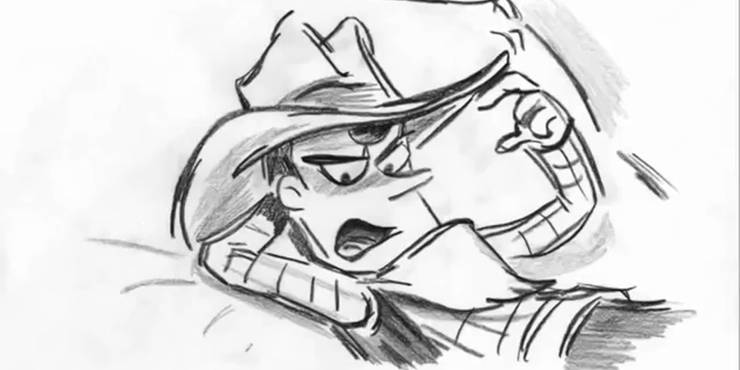The release of Toy Story in 1995, the first full-length CGI animated movie, was a landmark in filmmaking, but one bad early pitch reel almost got it canceled. Toy Story was Pixar’s premiere project, and its success rocketed the company into worldwide recognition. The film centers on a well-loved but resourceful gang of toys, led by their owner Andy’s favorite cowboy doll, Sheriff Woody (Tom Hanks). Woody is a kind and democratic leader, but he, like all toys, is ultimately motivated by his owner’s love. When Andy receives Buzz Lightyear (Tim Allen), a new spaceman action figure with bells and whistles the 40-year-old cowboy lacks, Woody grows jealous of Buzz seemingly taking his place in Andy’s heart. The film takes the initially quarrelsome pair on an adventure far beyond Andy’s room, where they learn to become best friends.
Although Woody’s envy leads him to poor decisions, he remains sympathetic throughout the film. In Toy Story‘s original plan, things were almost very different. Pixar wanted to set itself apart from typical Disney fairytales, but Jeffrey Katzenberg, chairman of Walt Disney Studios at the time of production, wanted them to do this by making the movie more edgy and adult. Following his advice, Toy Story began to stray further and further from the story Pixar set out to tell in the first place.
On November 19, 1993, Pixar showed a storyboard of half the film to Disney executives. The pitch – later dubbed the “Black Friday reel” – horrified the board with its mean-spirited tone. The presentation went so poorly that Disney threatened to shut down Toy Story‘s production entirely. Its central character, Woody, was the main reason for its poor reception, and Pixar had to scramble to revise the cowboy.

In the Black Friday reel, Woody is not a friendly, misguided leader, he’s an outright bully and Toy Story‘s true villain. In the surviving portion of the reel, taking place after Andy has to choose which toy to bring to Pizza Planet, Woody purposefully throws Buzz out of the window. He proudly admits what he did while relaxing on Andy’s bed. An argument with the other horrified toys ensues, with little levity and lots of name-calling. Woody explodes at Slinky Dog for not shutting down his detractors. From Slinky’s meek retorts to Woody’s commands to get the other toys off the bed, it is clear that Slinky is terrified of Woody and is forced to act as his lackey. Tom Hanks, the quintessential movie good guy, voices Woody in the reel, and hearing him insulting and shouting at his fellow toys is especially striking. At the end of the reel, Andy’s toys become fed up with Woody’s abuses and throw him out the window.
Disney’s executive board, including Roy E. Disney, hated the joyless reel, and demanded that Pixar lay off the people responsible for it. Now-disgraced director John Lasseter bargained with Disney to give them two weeks to revise Toy Story. During those weeks, Pixar investor Steve Jobs stepped in to fund the film, while animators worked day and night to fix its main character. They made Woody more sympathetic and changed Buzz’s fall from the window to be an accident.
The more likable Woody was essential to getting Disney back on board, but the two weeks of revisions also saw Toy Story‘s message and tone come together for the first time, elevating the story into greatness. To embody the film’s theme of friendship, the characters were better off optimistic and familial, not snarky and miserable. However, Jeffrey Katzenberg’s initial plans for edgy CGI animated films would not be lost completely. He later left Disney to co-found Dreamworks, which made its mark with Shrek, a manifestation of Katzenberg’s more cynical vision that actually worked.
About The Author



